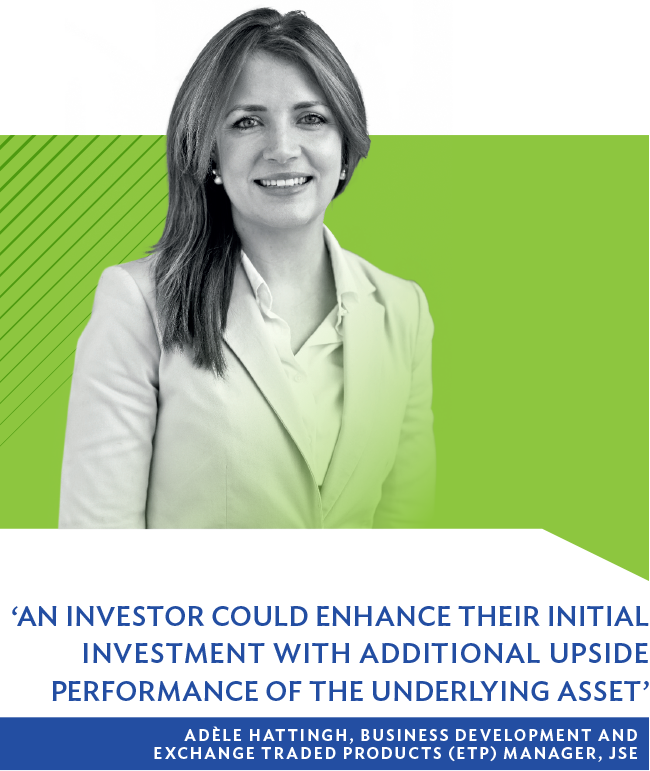Structured products listed on the JSE are customised vehicles designed to offer an investment strategy to investors. Adèle Hattingh, Business Development and Exchange Traded Products (ETP) Manager, in the JSE’s Primary Markets division, says these investments are fixed-term in nature and generally linked to the performance of a single security, a basket of securities (indices), commodities or foreign currencies. ‘Generally, embedded derivatives – for example, calls and puts – form part of the structure. These offer protection against adverse movements in the market. Structured products are typically short-term in nature, and run for between three to six or seven years until maturity.’
There are three basic risk/return profiles offered by structured products. Capital protection offers either ‘hard’ or ‘soft’ protection of invested capital at maturity, and the former is not dependent on the underlying asset’s performance. Secondly, products focused on yield enhancement would be favoured by investors seeking to benefit from a sideways movement in an underlying asset.
Finally, products offering leveraged performance would provide investors an opportunity to gain larger profits from smaller investment amounts. In other words, returns would increase faster than the prices of the underlying assets.
The majority of local banks are issuers of structured products listed on the JSE, and a number of international banks are also issuers in the SA market. Last year, 70 new structured products were listed on the JSE, with that number highly likely to be surpassed this year.
‘Structured products can assist investors who might have a particular outlook towards risk,’ says Hattingh. ‘For instance, a structured product focused on capital protection could help an investor when the market moves negatively but preserve the investor’s initial investment amount, helping to manage the investor’s risk concerns.
‘In a market performing strongly, an investor could enhance their initial investment with additional upside performance of the underlying asset being referenced. If this was the FTSE/JSE Top 40 Index, the investor could participate in additional upside in the index.’
Hattingh offers an example of a growth product that also provides ‘soft’ capital protection, which could be structured as follows: ‘The product could offer 100% capital protection plus 100% return on an underlying index – for example, the FTSE/JSE Top 40 Index – provided the investor keeps the investment until the end of the product’s life, that is, until maturity is reached, and provided the index’s performance doesn’t fall below its capital protection level.’
Provided the index hadn’t fallen below its protection level, the investor would receive their R100 000 initial investment at maturity plus the return of the FTSE/JSE Top 40 Index after three years. This is essentially a three-year FTSE/JSE Top 40 call option.
Listed structured products offer a number of benefits to investors. ‘Apart from capital protection, investors could also add diversification to their portfolio through the inclusion of a structured product that might offer difficult-to-access offshore exposure, leveraged returns on local asset classes or serve as an income product that delivers higher interest rate payments,’ says Hattingh.
While able to reduce the volatility (or risk) within an investment, these products can be a complementary allocation to a portfolio. Investors need to be aware, however, that they do not have share ownership rights, nor do they generally participate in the dividend flow from underlying companies.
They need to commit their investment for the entire life of the product in order to reap full benefits. These are buy-and-hold investments, as opposed to frequently traded instruments. Exiting before maturity is possible given that these are exchange traded, but this may attract charges or penalties, depending on the product and issuer.
Fees are a further consideration, as is the fact that upside growth can be capped by the issuer (depending on the product structure). Investors should understand the tax treatment of these products or opt for tax advice from a qualified tax practitioner.









